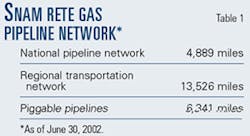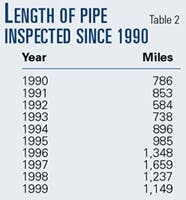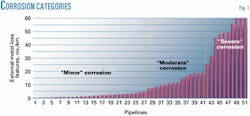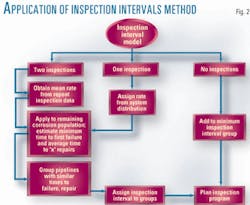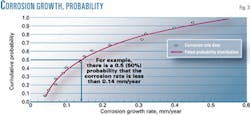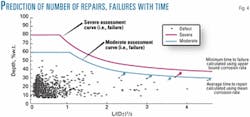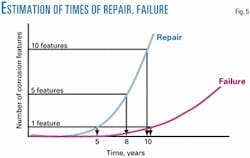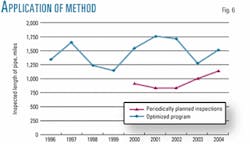Method to determine ILI intervals proven on Italian system
Based on a presentation to the Congreso Internacional de Ductos (Comité Interorganismos de Ductos de Petróleos Mexicanos), Mérida, Yucatán, Nov. 14 -16, 2001.
A method to determine safe and cost-effective intervals for conducting future intelligent pig inspections has been developed and validated with pipeline details and inspection data from a sample of 20 pipelines. These lines cover a representative range of age, diameter, number of external corrosion features, and corrosion growth rates.
After validation, the meth od was applied to the entire piggable network operated by SNAM Rete Gas SpA, Milan, an 18,000-mile gas pipeline network in Italy. Until 1999, pigging had been conducted only periodically.
Snam Rete Gas is the new brand name for the Eni Group Co. formed to acquire, own, and operate (as of July 2001) all natural gas transportation service assets previously owned by Snam SpA.
This merger anticipates the coming into force of the new Italian regulation that envisions separation of natural gas transmission activities from the other activities of the gas sector.
The majority of the piggable pipeline network has been inspected (using intelligent pigs) at least once and many of the pipelines in the network have been inspected twice. Consequently, a significant knowledge of the condition of the pipeline network has been accumulated.
This greater understanding of the integrity of the pipeline network can now lead to a more effective use of resources devoted to pipe line safety.
The developed method has resulted in a significant reduction in terms of miles to be inspected over the next 4 years and, consequently, a significant reduction in the cost of the inspection program.
A software program, Pipeline Ranking System, was developed to apply the methodologies to the SNAM Rete Gas pipelines, to store and provide easy access to the relevant pipeline input data, and to facilitate future updating by SNAM Rete Gas with the findings of future inspections and other maintenance activities.
The method permits available resources to be better used in a disciplined process of integrity assessment, delivering an equivalent or higher level of safety, environmental protection, and reliability.
Inspection record
The pipeline system operated by SNAM Rete Gas varies in age from recent construction to more than 50 years. The system is also diverse with respect to pipe diameter, coating type, and soil conditions.
Most of the high pressure, long-distance transport pipelines are piggable. The Snam Rete Gas pipeline network (Table 1) is subdivided into two main classes: a national pipeline network and a regional transportation network consisting of 4,889 miles of high pressure, large-diameter pipe and sealine identified according to Italian law. This network is designed to transport large quantities of gas from terminals to points of interconnection with the regional transportation network.
The regional network consists of 13,526 miles of lower pressure, smaller diameter pipe designed to distribute natural gas within specific regions to industrial customers and local gas distribution companies.
By any statistical measure, pipelines are demonstrably one of the safest and more efficient forms of transporting energy. They can be damaged during construction and operation, however, and are susceptible to time-dependent deterioration. Management of these assets requires continued integrity assurance of the ageing system.
Periodic maintenance is required to ensure efficient operation of the network. Condition monitoring of this pipeline network is conducted utilizing periodic intelligent pig inspection (to monitor corrosion development), cathodic-protection (CP) surveys (to determine the effectiveness of the corrosion-protection system), aerial and aboveground surveillance (to monitor third-party interference activities), and geological surveys (to prevent ground movement).
SNAM Rete Gas has been using in-line-inspection (ILI) tools since 1982 for assessing the integrity of its pipelines. After early experiences with these tools, their capabilities have constantly been upgraded with rapid advances in technology, and SNAM Rete Gas began using magnetic flux leakage (MFL) high-resolution intelligent pigs regularly from the late 1980s.
Pigging was previously conducted at periodic intervals. Table 2 shows the length of pipe inspected in the SNAM Rete Gas network from 1990 to 1999. More than 10,000 miles have been inspected during the last 10 years. The majority of the piggable pipeline network has been inspected at least once and many of the pipelines in the network have been inspected twice.
Consequently, a significant knowledge of the condition of the pipeline network has been accumulated. This greater understanding of the integrity of the pipeline network can now lead to a more effective use of resources devoted to pipeline safety.
As experience is gained and data are accumulated, it may subsequently be possible to justify longer intervals between surveys, delivering an equivalent or higher level of safety, environmental protection, and reliability.
Condition assessment
The first priority of the pipeline industry is to ensure safe and reliable delivery of natural gas at reasonable costs. As have other pipeline operators, Snam Rete Gas has adopted pipeline protection and condition-monitoring strategies aimed at ensuring the fitness-for-purpose of the gas transmission network in the safest and most cost effective way.
The many thousands of miles of high-pressure pipelines installed require an optimal utilization of available resources. The "safety at any cost" approach, with no consideration of the actual impact on pipeline integrity, may result in a spiraling growth of costs for inspections and maintenance, without necessarily improving pipeline safety.
A planned inspection program is essential in maintaining overall integrity of an entire pipeline network. Needing to determine which pipelines would be inspected early in the program, SNAM Rete Gas in 1999 contracted with PII Pipeline Solutions, Cramlington, UK, (formerly PII Ltd.) to utilize the extensive condition monitoring information collected on its pipeline network to develop a method to determine safe and cost-effective intervals for conducting future intelligent pig inspections of individual pipelines.
The purpose was to assess pipeline deterioration and degradation over time and to consequently inspect a pipeline before corrosion becomes significant.
Selection of pipelines
The inspection-intervals method was based on the data (pipeline geometry, operating conditions, geological, corrosion protection, inspection results, corrosion rates, etc) from a sample of 12 pipelines from the Snam Rete Gas primary network. The pipeline sample was selected based on the following procedure:
- Pipelines that had been inspected two or more times (to obtain actual corrosion growth rate data) were identified. (The inspection data for 51 pipelines were restored from PII's archives.)
- These pipelines were categorized according to the number of external metal-loss (i.e., external corrosion) features per km as containing either minor, moderate, or extensive corrosion. The categories were arbitrarily defined; minor being less than 5 features/km, moderate was 5-20 features/km, and extensive was greater than 20 features/km (Fig. 1).
Four pipelines from each of these categories were selected so that the overall sample of 12 pipelines contained a representative range of age, diameter, and external corrosion features.
A further eight pipelines selected by SNAM Rete Gas were used to extend the sample and assist in validation of the method, the results of which are discussed presently. The sample of 20 pipelines reasonably represents the SNAM Rete Gas pipelines that have been inspected two or more times in relation to pipeline age and size.
Inspection method
The method has been based on preventing failures occurring from external corrosion damage. Other types of failures, especially third-party interference and ground movement, are not time-dependent but generally are caused by instantaneous events and therefore can hardly be influenced or prevented by conducting intelligent pig inspections.
Consequently, these failure mechanisms were not considered in the method.
The method predicts the future behavior of external corrosion in individual pipelines in terms of the number of corrosion features that require repair or could cause failure as a function of time. From this prediction, the optimum timing of the next inspection can be selected.
Following is a description of the method, complemented by Fig. 2.
The first step was to obtain the external corrosion data and determine current corrosion growth rates from repeat inspection data for the sample pipelines. The deepest external corrosion boxes (as reported in the most recent inspection) were matched in both sets of inspection data.
The differences in depth and in length were calculated and converted to a corrosion growth rate (assuming a constant rate of growth in the period between the inspections). Mean and standard deviation growth rate statistics were calculated from these data.
The corrosion rate data collected using the procedure described previously were converted to a cumulative probability distribution (Fig. 3).
If no information is available on the corrosion growth rate for a particular pipeline (e.g., if only one inspection has been performed), the corrosion growth rate can then be estimated from this corrosion rate probability distribution.
For example, if a pipeline is considered to have a "high" risk of external corrosion, the corrosion rate corresponding to the 95% (upper bound) probability value (i.e., 0.50 mm/year) could be selected.
Alternatively, if a pipeline has a "moderate" risk of external corrosion, the 50% probability rate (0.14 mm/ year) would be recommended; or if the pipeline has a "low" risk, the 5% probability rate (0.04 mm/year) would be recommended.
For pipelines that have never been inspected, there is no method of predicting the extent of corrosion or the corrosion growth rate; therefore the recommendation is to inspect these pipelines as soon as practically possible.
The relationship between the number of repairs and time is predicted by a calculation of the time to repair for each of the external corrosion features (as reported in the last inspection) growing at the mean corrosion growth rate (Fig. 4), according to the SNAM Rete Gas repair criteria.
Note it is assumed that SNAM Rete Gas has already repaired all the features that exceed the moderate assessment curve. The time to failure is predicted by application of the upper bound corrosion growth rate (mean plus two standard deviations) to the corrosion features and therefore calculating the minimum time for the features to exceed the severe assessment curve.
Interval selection; applying method
The minimum time for either:
- One feature to grow to a size that could cause failure (i.e., exceed the severe curve); or,
- 'X' features to grow to a size that requires repair (i.e., exceed the moderate curve)
is estimated by using the procedure described previously. The inspection interval is then assigned to prevent the growth of a significant number of defects, degradation mechanisms having been analyzed in detail and the rate assessed at which defects require repair over time (Fig. 5).
In this way, the inspection activity is optimized and the operator remains confident that the asset is not approaching failure.
The inspection interval for each pipeline should be recalculated after every pig inspection and if there is evidence that the corrosion growth rate has changed, e.g., if any major problems occur with the CP system (i.e., rectifier failure, insulation joint failure, occurrence of severe stray current interference, etc.) or if new corrosion or significant growth is identified between inspections.
Findings; program
The inspection-intervals method was applied first of all to the sample of 12 pipelines and then to the additional 8 pipelines. A critical review of the findings for the 20 pipelines concluded that the findings accurately reflect the input data provided and engineering judgment.
On the above basis, the method has been fully validated based on the 20 SNAM Rete Gas pipelines studied.
The described method was applied to the entire piggable SNAM Rete Gas primary network (more than 150 pipelines, about 6,300 miles), in order to plan the inspection programs for 2000 and the following years.
Fig. 6 shows the resulting benefits in terms of optimization of the inspection activities. The diagram shows two curves, the number of miles to be inspected on the basis of periodically planned inspections and the number of miles according to the more rational, optimized approach.
Because the method involves many calculations, a software program (Pipeline Ranking System) was developed to run it. The software allows:
- Rapid implementation of the inspection-intervals method.
- Identification of the optimum interval for inspection to be determined for each individual pipeline.
- Storage of and easy access to all the relevant pipeline input data to facilitate future updating by SNAM Rete Gas.
- Sensitivity studies to be conducted; for example, sensitivity of the inspection interval to the rate of external corrosion growth and sensitivity of the criticality factors to different parameters,
- The calculated inspection intervals to be output in a format compatible with Microsoft Windows applications, for example, Access, Excel, Word format.
- The pipeline inspection data (from PII and other inspection vendors) for the remainder of the SNAM Rete Gas pipeline network and for future pipelines to be added.
The authors
D. Scrocchi is currently senior engineer at the innovation department at SNAM Rete Gas SpA, San Donato Milanese, Italy. He was previously responsible for managing pig inspections and repairs at the technical department of SNAM. He holds a degree in mechanical engineering (1990) from the University of Milan.
Jane Dawson is an integrity manager with the PII Pipeline Solutions division of GE Power Systems Oil & Gas, Cramlington, UK. She has also served as a senior engineer for British Gas PLC. Dawson holds a BSc (honors; 1988) in mathematics from the University of Northumbria, UK.

